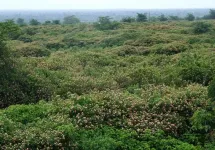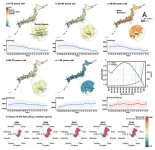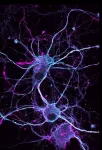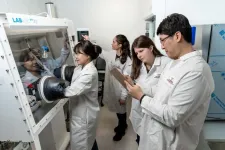(Press-News.org) New CABI-led research using publicly-shared DNA barcodes and citizen science images have provided new evidence on the establishment and spread of a biological control agent used for the control of the major invasive shrub Lantana camara.
Lantana camara was introduced as a garden and ornamental plant throughout the tropics and subtropics but is now pervasive throughout the Old World, invading woodlands, forestry, orchards, grasslands, and disturbed areas, where is displaces useful and indigenous plants.
Dr Matthew Cock, CABI Emeritus Fellow, and colleagues took DNA barcodes from the Barcode of Life Data System (BOLD) and citizen science images from the iNaturalist and Afromoths websites to detect the establishment of the biological control agent Orphanostigma haemorrhoidalis (Guenée) (Lepidoptera, Crambidae) – which is used to tackle L. camara – in countries where it has not previously been reported.
In this research, the scientists used for the first time a combination of publicly shared DNA barcodes and citizen science images to assess the establishment and spread of an introduced weed biological control agent, O. haemorrhoidalis, as well as confirm historical distribution and establishment records reported in the literature.
Two genetically distinguishable populations of O. haemorrhoidalis
Dr Cock, and colleagues from Australia’s Department of Agriculture, Fisheries and Forestry, the United States Department of Agriculture (USDA) and MIA Consulting, found that there are two genetically distinguishable indigenous populations of O. haemorrhoidalis in the Americas, one in south-eastern USA and the other widespread in the rest of the Neotropics.
These two populations were introduced into different parts of the World and subsequently spread.
The scientists, whose research was published in the journal CABI Agriculture and Bioscience, used DNA barcodes from BOLD to clarify that a population from Florida is established in Hawai’i, Australia and Fiji, while a population from Trinidad is established in parts of mainland Africa (including new records for Cameroon, Nigeria and Ghana), Madagascar, Mauritius and La Réunion.
New country records for O. haemorrhoidalis were established from iNaturalist images from Eswatini, Kenya, and Mozambique, and from Afromoths for Tanzania.
Presence of O. haemorrhoidalis in its introduced range and beyond
Dr Cock said, “The DNA barcodes publicly shared by scientists on BOLD, and images shared by citizen scientists on iNaturalist, confirm the presence of O. haemorrhoidalis in much of its introduced range as well as several countries where it had not been previously reported.”
He said the use of unique Barcode Index Numbers (BINs) which are assigned to clusters of similar DNA barcodes, has enabled the introductions of O. haemorrhoidalis from Florida and Trinidad to be tracked separately.
Dr Cock added, “Based on our findings, we conclude as follows. Orphanostigma haemorrhoidalis derived from Trinidad is now widespread in Africa and the Mascarenes and can be expected to continue to spread throughout sub-Saharan Africa where lantana occurs.
“Orphanostigma haemorrhoidalis derived from Florida is established in Hawai’i, Australia and Fiji and we assume is the BIN present on Norfolk Island and in the other Pacific countries where it is known to occur (Federated States of Micronesia, Niue, Tonga, and Vanuatu). Based on the evidence available it appears that this is the only BIN established from the introductions into Hawai’i, and onward from there.”
In 2022, CABI scientists contributed to research, published in the journal Plant-Environment Interactions which showed how L. camara reduced the growth of maize in East Usambara, Tanzania, by 29%.
They sought to gain a better understanding of immediate as well as legacy effects and of direct and indirect impacts of L. camara for improved management of invaded cropland.
Online social network of people sharing biodiversity information
iNaturalist is an online social network of people sharing biodiversity information to help each other learn about nature. It is also a crowdsourced species identification system and an organism occurrence recording tool.
It can be used to record users’ own observations, get help with identifications, collaborate with others to collect this kind of information for a common purpose, or access the observational data collected by iNaturalist users.
Afromoths, meanwhile, provides an online database of the Afrotropical moth species (Lepidoptera), updated with the latest information obtained from 10,000+ published sources and studies.
The main objective of this searchable website is to make all relevant information on every Afrotropical moth species hitherto known, accessible to any user worldwide.
Full paper reference
Cock, M.J.W., Day, M.D. & Winston, R.L. Publicly-shared DNA barcodes and citizen science images provide new evidence on the establishment and spread of the lantana weed biological control agent, Orphanostigma haemorrhoidalis (Lepidoptera, Crambidae) CABI Agric Biosci, 7 February 2025, DOI: 10.1079/ab.2025.0010
The paper can be accessed here from 10:00hrs UK time on Friday 7 February 2025: https://www.cabidigitallibrary.org/doi/10.1079/ab.2025.0010
END
DNA barcodes and citizen science images map spread of biocontrol agent for control of major invasive shrub
New CABI-led research using publicly-shared DNA barcodes and citizen science images have provided new evidence on the establishment and spread of a biological control agent used for the control of the major invasive shrub Lantana camara.
2025-02-07
ELSE PRESS RELEASES FROM THIS DATE:
Pregnancy complications linked to cardiovascular disease in the family
2025-02-07
Women who have experienced pregnancy complications have an increased risk of cardiovascular disease. Now, a new study from Karolinska Institutet published in the European Heart Journal shows that sisters of women with complicated pregnancies are also at higher risk, even if they had uncomplicated pregnancies. The findings suggest that genes and shared environmental factors may influence the association between pregnancy complications and cardiovascular disease risk.
It is well known that complications during pregnancy, such as high blood pressure and premature labour, increase the risk of cardiovascular disease later in life. However, it is unknown whether ...
Pancreatic cancer immune map provides clues for precision treatment targeting
2025-02-07
Pancreatic cancer patients may benefit from future precision treatments as a new study shows how some tumours may potentially be more susceptible to macrophage-based therapies.
The study which is published in Nature Communications was led by Associate Professor Shivan Sivakumar from the University of Birmingham and Associate Professor Rachael Bashford-Rogers at the University of Oxford and provides the most detailed immune map for pancreatic cancer. The findings suggest that some tumour cells ...
How neighborhood perception affects housing rents: A novel analytical approach
2025-02-07
Housing rents usually correlate with factors such as the building’s age, facilities, and location. Yet not all rentals with similar physical factors charge the same rent. Psychological factors such as the subjective perceptions of the neighborhood matter as well.
Considering these perception variables, an Osaka Metropolitan University team has developed a method with almost 75% accuracy in explaining housing prices in Osaka City.
The team led by Graduate School of Human Life and Ecology student Xiaorui Wang and Professor Daisuke Matsushita used existing Osaka City property datasets and incorporated additional information on the physical factors (sky, vegetation, and buildings) of ...
Many adults report inaccurate beliefs about risks and benefits of home firearm access
2025-02-07
About 40% of households in the United States report firearm access and the majority of firearm owners report typically storing at least one of their firearms unsecured.
The most common reason individuals provide for when asked why they store firearms unsecured is defense, with many reporting that firearms are unrelated to suicide risk despite robust data to the contrary.
A new study by the New Jersey Gun Violence Research Center clarified the extent to which U.S. adults exhibit skewed perceptions of risk and safety by collecting a nationally representative sample of 8,009 adults in May and asking participants about the extent to which they believe ...
Air pollution impacts an aging society
2025-02-07
Air pollution is a growing health issue worldwide, and its impacts are often underestimated in aging societies like Japan. A new study led by researchers from the University of Tokyo highlights how fine particulate pollution, or PM2.5, not only worsens health outcomes, but also creates significant socioeconomic challenges in regions with aging populations and limited medical resources. The researchers hope these findings motivate policymakers to tackle the interrelated issues behind this problem.
PM2.5 refers to microscopic particles of pollution small enough to penetrate deep into the lungs and bloodstream, leading to severe respiratory and cardiovascular ...
UC Davis researchers achieve total synthesis of ibogaine
2025-02-07
Ibogaine — a psychoactive plant derivative — has attracted attention for its anti-addictive and anti-depressant properties. But ibogaine is a finite resource, extracted from plants native to Africa like the iboga shrub (Tabernanthe iboga) and the small-fruited voacanga tree (Voacanga africana). Further, its use can lead to irregular heartbeats, introducing safety risks and an overall need to better understand how its molecular structure leads to its biological effects.
In a study appearing in Nature Chemistry, researchers at the University ...
Building better biomaterials for cancer treatments
2025-02-07
Modifying the physical characteristics of microscopic biomaterials to interact seamlessly with the body’s tissues could unlock safer and more effective cancer treatments, according to Virginia Tech researchers at the Fralin Biomedical Research Institute at VTC.
In an online review slated for the Feb. 10 issue of the Journal of Controlled Release, a research team led by DaeYong Lee, an assistant professor with the institute’s Cancer Research Center in Roanoke, highlighted how slight changes in therapeutic ...
Brain stimulation did not improve impaired motor skills after stroke
2025-02-06
Research Highlights:
Neither a placebo procedure nor two different doses of transcranial brain stimulation, which send electrical signals through the skull, improved mobility recovery in stroke survivors receiving movement therapy.
Motor function was similar among survivors who received electrical brain stimulation combined with movement therapy or a placebo combined with movement therapy.
Note: The study featured in this news release is a research abstract. Abstracts presented at the American Heart Association’s ...
Some species of baleen whales avoid attracting killer whales by singing too low to be heard
2025-02-06
Killer whales are the only natural predator of baleen whales — those that have “baleen” in their mouths to sieve their plankton diet from the water. More solitary than toothed whales, baleen whales face predatory attacks from killer whales, especially mother and calf pairs. When attacked, some species fight back, while others choose flight.
But whale species also produce loud underwater songs. What stops killer whales from homing in on their calls and attacking them?
New research from the University of Washington finds some baleen whale species call at such deep frequencies that they’re completely undetectable ...
Wasteful tests before surgery: Study shows how to reduce them safely
2025-02-06
For many patients, getting ready to have surgery means getting their blood drawn, their heart rhythm checked, or having other tests in the weeks leading up to their operation.
But not all patients need all those tests -- especially if the results won’t change how their surgical team treats them or how well they do afterward.
Now, a new study shows how hospitals can focus the use of such tests on the patients who truly need them, while safely reducing unnecessary testing in others.
The result: less wasted money and resources for each test, and less wasted time for patients and clinical staff.
The study, published in JAMA ...
LAST 30 PRESS RELEASES:
Normalizing blood sugar can halve heart attack risk
Lowering blood sugar cuts heart attack risk in people with prediabetes
Study links genetic variants to risk of blinding eye disease in premature infants
Non-opioid ‘pain sponge’ therapy halts cartilage degeneration and relieves chronic pain
AI can pick up cultural values by mimicking how kids learn
China’s ecological redlines offer fast track to 30 x 30 global conservation goal
Invisible indoor threats: emerging household contaminants and their growing risks to human health
Adding antibody treatment to chemo boosts outcomes for children with rare cancer
Germline pathogenic variants among women without a history of breast cancer
Tanning beds triple melanoma risk, potentially causing broad DNA damage
Unique bond identified as key to viral infection speed
Indoor tanning makes youthful skin much older on a genetic level
Mouse model sheds new light on the causes and potential solutions to human GI problems linked to muscular dystrophy
The Journal of Nuclear Medicine ahead-of-print tip sheet: December 12, 2025
Smarter tools for peering into the microscopic world
Applications open for funding to conduct research in the Kinsey Institute archives
Global measure underestimates the severity of food insecurity
Child survivors of critical illness are missing out on timely follow up care
Risk-based vs annual breast cancer screening / the WISDOM randomized clinical trial
University of Toronto launches Electric Vehicle Innovation Ontario to accelerate advanced EV technologies and build Canada’s innovation advantage
Early relapse predicts poor outcomes in aggressive blood cancer
American College of Lifestyle Medicine applauds two CMS models aligned with lifestyle medicine practice and reimbursement
Clinical trial finds cannabis use not a barrier to quitting nicotine vaping
Supplemental nutrition assistance program policies and food insecurity
Switching immune cells to “night mode” could limit damage after a heart attack, study suggests
URI-based Global RIghts Project report spotlights continued troubling trends in worldwide inhumane treatment
Neutrophils are less aggressive at night, explaining why nighttime heart attacks cause less damage than daytime events
Menopausal hormone therapy may not pose breast cancer risk for women with BRCA mutations
Mobile health tool may improve quality of life for adolescent and young adult breast cancer survivors
Acupuncture may help improve perceived breast cancer-related cognitive difficulties over usual care
[Press-News.org] DNA barcodes and citizen science images map spread of biocontrol agent for control of major invasive shrubNew CABI-led research using publicly-shared DNA barcodes and citizen science images have provided new evidence on the establishment and spread of a biological control agent used for the control of the major invasive shrub Lantana camara.




